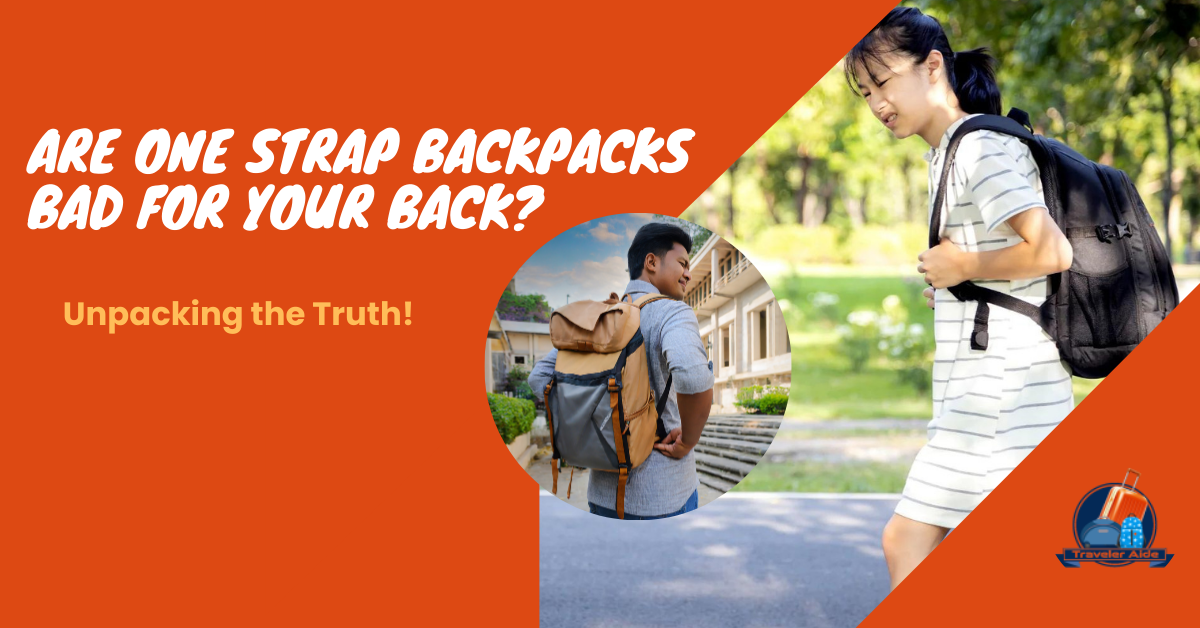Hey, my dear travelers and backpack lovers! Welcome to another edition of “Traveler Aide,” where my teammates and I delve into the world of backpacks and explore their impact on our literal and figurative travel journey.
As an backpack specialist with years of experience traversing the globe, I’ve had the privilege of witnessing firsthand the transformational power of backpacks. They’re our trusty companions, bearing the weight of our adventures, hopes, and dreams. But when it comes to one-strap backpacks, a tinge of concern often arises, “Are one-strap backpacks bad for your back?”
That’s why today, I’ll tackle the question that has been lingering in the minds of many backpack lovers. So, let’s start a journey with me about one-strap backpacks Back Bad – from my backpack expertise perspective and also my practical usage experience.
Can a Backpack Have One Strap?
Yes, a backpack can have one strap, and such a design is often referred to as a “sling backpack” or a “one-strap backpack.” These backpacks typically have a single shoulder strap backpack that allows the bag to be worn diagonally across the body. This design is popular for its ease of access and is often used for smaller and lighter loads.
Sling backpacks are commonly used for activities like hiking, cycling, or urban commuting, where users may need quick and convenient access to their belongings. The single strap allows for easy rotation of the backpack to the front of the body, providing quick access to the contents without having to take the backpack off completely.
It’s worth noting that the terms “sling backpack” and “one-strap backpack” are sometimes used interchangeably, but they generally refer to the same style of backpack with a single shoulder strap.
Are One-Strap Backpacks Bad for Your Back- A Comprehensive Guide
Yes, one-strap backpacks can be bad for your back. When you carry a backpack on one shoulder, you are placing all of the weight on one side of your body. This can cause your spine to curve, leading to pain and discomfort. Over time, this can even lead to scoliosis, a curvature of the spine.
However, the convenience and style of one-strap backpacks often raise concerns about their impact on our musculoskeletal health. Here’s a comprehensive guide with my Usage personal experience to help you make informed decisions regarding one-strap backpacks and your back health.
01. Understanding the Back Pain Concern
One-strap backpacks, also known as sling bags or messenger bags, distribute weight unevenly across one shoulder. This imbalance can lead to muscle strain, back pain, and even potential spinal misalignment. The discomfort can be particularly acute for individuals with pre-existing back conditions.
02. Factors Influencing the Impact of One-Strap Backpacks
- Weight of the Load: The heavier the load, the greater the strain on your back.
- Duration of Use: Prolonged use of a one-strap backpack increases the risk of discomfort and potential injuries.
- Individual Back Health: Pre-existing back conditions make individuals more susceptible to pain and strain from one-strap backpacks.
- Posture and Gait: Poor posture and improper walking patterns can exacerbate the negative effects of one-strap backpacks.
03. Strategies to Minimize Risks with One-Strap Backpacks
- Choose Lightweight Bags: OPT for lightweight one-strap backpacks to reduce the strain on your back.
- Limit Weight Carried: Pack only essential items to minimize the load on your shoulder.
- Switch Shoulders Frequently: Alternate shoulders regularly to distribute weight more evenly.
- Maintain Good Posture: Practice proper posture while walking or standing to avoid additional strain.
- Seek Professional Guidance: Consult a healthcare professional if you experience persistent discomfort or pain.
04. When to Consider Two-Strap Backpacks
- Extended Travel or Heavy Loads: For extended journeys or carrying heavier items, two-strap backpacks are strongly recommended from other strap backpack.
- Back Pain Concerns: If you have back pain or a history of back problems, opt for two-strap backpacks for better support and weight distribution.
- Preventive Measures: Even if you don’t currently experience back pain, consider using two-strap backpacks regularly to avoid potential issues in the future.
Remember, your back health is paramount. Choose backpack options that align with your needs and comfort level, and prioritize proper use to minimize risks and maximize the benefits of your trusty backpack companion.
My Experience with One-Strap Backpacks ---------------------------------------------------------------- Over the years, I've had my fair share of experiences with one-strap backpacks. While their convenience and style are undeniable, I've also witnessed the toll they can take on my back. On extended journeys, I've often felt the strain of carrying a heavy load on one shoulder, leading to stiffness and discomfort. To alleviate these issues, I've adopted a few strategies. First, I prioritize lightweight bags when using a one-strap design. Second, I limit the amount of weight I carry in the bag, opting for a smaller selection of essentials. Finally, I make a conscious effort to switch shoulders frequently to distribute the weight more evenly.
Recommendation of My Teammate ‘Travis Bryant’- A Hand Back Specialist’s
While one-strap backpacks offer convenience and style, they come with potential risks to our back health. For extended travel or heavy loads, I strongly recommend opting for traditional two-strap backpacks. Two straps ensure even weight distribution, minimizing the strain on our muscles and spine.
However, if you’re drawn to the style and convenience of one-strap backpacks, heed these guidelines:
- Choose a lightweight bag.
- Limit the weight you carry.
- Switch shoulders frequently.
- If you experience persistent discomfort, switch to a two-strap backpack.
Remember, our backpacks should enhance our journeys, not compromise our well-being. Prioritize your back health, and your adventures will be all the more enjoyable.
Happy travels and stay tuned for more backpack adventures!
- Travis Bryant, –A Hand Back Specialist’s
How to Wear a Backpack for Back Pain Prevention?
Here are some tips on how to wear your backpack to prevent back pain:
- Choose a backpack with two padded shoulder straps. Two shoulder straps evenly distribute weight, reducing strain on one side of your body. Padded straps also provide comfort and help to reduce the risk of shoulder pain.
- Adjust the straps so the backpack fits snugly against your back. A snug fit prevents the backpack from bouncing or shifting, reducing muscle strain. The bottom of the backpack should rest on your lower back, and the shoulder straps should be tight enough so that you can still lift your arms comfortably.
- Pack heavier items closer to your back. Packing heavy items closer to your back keeps the weight centered, reducing stress on your spine. Pack lighter items, such as a jacket or water bottle, in the outer pockets of the backpack.
- Avoid carrying more weight than you can comfortably handle. Overloading your backpack can lead to muscle fatigue and back pain. If you need to carry a lot of weight, consider using a backpack with a waist strap to help distribute the weight more evenly.
- Take breaks frequently to rest your back. Taking breaks allows your muscles to rest and recover, preventing discomfort and potential injuries. Get up and move around every 20-30 minutes to stretch and loosen your muscles.
How to Fix a Backpack Strap?
To fix a backpack strap, first, identify the issue. If it’s a simple tear, use a heavy-duty needle and strong thread to stitch the torn parts together, reinforcing the area with additional stitches for durability. For more extensive damage, consider using a fabric patch on both sides of the strap to provide extra support. If the issue lies with a buckle or adjuster, determine if it can be repaired or if a replacement is necessary.
In the case of a broken buckle, replace it with a new one by threading the strap through the new buckle and securing it in place. If an adjuster is the problem, follow the instructions for replacing it, ensuring the strap is threaded correctly. Regularly inspect your backpack for wear and tear, addressing issues promptly to prevent further damage and extend the life of your bag.
How to Replace Backpack Strap Adjuster?
To replace a backpack strap adjuster, start by identifying the type of adjuster on your backpack. Most backpacks have either a ladder lock or a tri-glide adjuster. For a ladder lock adjuster, release the strap from the ladder by pushing the release lever. Slide the old adjuster off and replace it with the new one, threading the strap back through the ladder.
For a tri-glide adjuster, locate the end of the strap with the adjuster attached. Slide the strap out of the tri-glide and remove the old adjuster. Insert the new adjuster, ensuring the strap is threaded correctly through all openings. Pull the strap tight to secure the adjuster in place.
Double-check that the strap is securely fastened and make any necessary adjustments for a comfortable fit. Regularly inspect and maintain your backpack’s straps to ensure longevity and optimal functionality.
Conclusion: Prioritize Back Health with One-Strap Backpacks
As I conclude my exploration of one-strap backpacks and their potential impact on back health, it’s evident that prioritizing two-strap backpacks is the safer and more ergonomic choice for extended use or carrying heavier loads. By evenly distributing weight across both shoulders, two-strap backpacks minimize strain on muscles and ligaments, promoting better posture and reducing the risk of back pain.
While one-strap backpacks may offer convenience and style, their potential drawbacks cannot be ignored. The uneven weight distribution caused by the single strap can lead to muscle fatigue, postural strain, and even long-term back issues.
By following the additional tips outlined in this blog post, you can further safeguard your back health while enjoying the benefits of backpacks.
Remember, a healthy back is essential for enjoying life’s adventures to the fullest. Try to healthy backpack usage practices to keep your spine happy and your journeys pain-free. Happy trails!
FAQ: One-Strap Backpacks Impact on Back Health
Q1: Is it bad to carry a backpack on one shoulder?
Carrying a backpack on one shoulder can lead to uneven weight distribution, potentially causing strain on the neck, shoulders, and back. Over time, this imbalance may contribute to postural issues and discomfort. It is generally recommended to use both shoulder straps to distribute the load more evenly.
Q2: Are backpacks bad for the spine?
Backpacks, when worn properly with both shoulder straps, are generally considered a safe and efficient way to carry belongings. However, if a backpack is too heavy or not worn correctly, it may lead to spine-related issues. It’s essential to choose a backpack with proper support, distribute weight evenly, and adjust the straps to ensure a snug fit.
Q3: Do crossbody bags hurt your back?
Crossbody bags can cause strain on one side of the body due to the asymmetrical weight distribution. If the bag is overloaded or worn for extended periods, it may contribute to back and shoulder discomfort. It’s advisable to choose a crossbody bag with a wide and adjustable strap, distribute the weight evenly, and switch sides periodically to minimize the risk of strain.

Hey, I’m Dorothy E. Turner! I’ve spent years exploring the world and diving deep into the travel scene. Along the way, I’ve developed a real knack for understanding what makes a great travel backpack. I’m passionate about sharing my expertise to help fellow travelers find the perfect backpack for their adventures.


